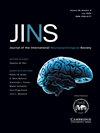78 D-KEFS 颜色词干扰测验作为对转诊接受心理教育评估的成年人的表现效度测量的实用性
IF 2.6
4区 心理学
Q2 CLINICAL NEUROLOGY
Journal of the International Neuropsychological Society
Pub Date : 2023-12-22
DOI:10.1017/s1355617723009360
引用次数: 0
摘要
目的:之前的研究已经证明了德利斯-卡普兰执行功能系统(Delis-Kaplan Executive Function System,D-KEFS)颜色词干扰测试(Color Word Interference Test,CWIT)作为嵌入式效度指标在混合临床样本和创伤性脑损伤中的临床实用性。本研究试图在转诊接受心理教育测试的成人样本中交叉验证之前确定的指标和临界值。参与者和方法:本研究分析了267名学生和社区成员在南方一所大学诊所自我转诊接受心理教育评估的档案数据。转诊包括注意力缺陷多动障碍、特殊学习障碍、自闭症谱系障碍或其他障碍(如焦虑症、抑郁症)的评估。作为评估的一部分,对个人进行了 D-KEFS 的子测试,包括 CWIT 以及几个独立的和嵌入式的表现效度指标。标准测量包括 b 测试、维多利亚症状有效性测试、医学症状有效性测试、点计数测试和可靠数字跨度。未通过 0 项标准测量的个体被纳入可信组(n = 164),未通过 2 项或更多标准测量的个体被纳入不可信组(n = 31)。由于一部分样本正在寻求外部激励(如住宿),因此仅有 1 项标准测量未通过的个体被排除在外(n = 72)。相关指标包括所有单独考察的测试条件、倒置斯特罗普指数(即在干扰试验中的表现优于单词阅读或颜色命名试验)、抑制和抑制/切换综合以及所有条件的总和。结果:接收者操作特征(ROC)曲线对所有四种条件(p <.001)和倒置斯特罗普指数(p = .032)均有显著意义。然而,只有条件 2、3 和 4 达到了可接受的最低分类准确度(AUC = .72 - 81)。综合指标的 ROC 曲线也有显著意义(p < .001),所有三个综合指标都达到了可接受的最低分类准确度(AUC = .71- .80)。在之前确定的所有四种情况的年龄校正量表评分 6 分的临界值下,特异性较高(.88 - .91),灵敏度不一(.23 - .45)。在之前确定的倒 stroop 指数 0.75 的临界值下,特异性较高(0.87),而敏感性较低(0.19)。在之前确定的临界值下,综合指标的特异性较高(0.88 - 0.99),灵敏度从低到中等不等(0.19 - 0.48)。提高综合指标的临界值(即要求更高的年龄校正量表得分才能通过)可提高灵敏度,同时仍保持较高的特异性。例如,将总分分界点从 18 分提高到 28 分,灵敏度为中等(.26 vs .52),特异性为 0.91。结论:虽然 6 分的分界点对大多数情况都有较高的特异性,但所有四种情况的总和表现出最强的分类准确性,似乎是最稳健的指标,这与之前的研究(Eglit et al.)不过,对于心理教育样本来说,28 分界点可能比 18 分界点更合适。总之,研究结果表明,D-KEFS CWIT除了可以测量处理速度/执行功能外,还可以作为一种成绩效度测量方法。本文章由计算机程序翻译,如有差异,请以英文原文为准。
78 Utility of the D-KEFS Color Word Interference Test as a Measure of Performance Validity in Adults Referred for a Psychoeducational Evaluation
Objective:Previous investigations have demonstrated the clinical utility of the Delis-Kaplan Executive Function System (D-KEFS) Color Word Interference Test (CWIT) as an embedded validity indicator in mixed clinical samples and traumatic brain injury. The present study sought to cross-validate previously identified indicators and cutoffs in a sample of adults referred for psychoeducational testing.Participants and Methods:Archival data from 267 students and community members self-referred for a psychoeducational evaluation at a university clinic in the South were analyzed. Referrals included assessment for attention-deficit hyperactivity disorder, specific learning disorder, autism spectrum disorder, or other disorders (e.g., anxiety, depression). Individuals were administered subtests of the D-KEFS including the CWIT and several standalone and embedded performance validity indicators as part of the evaluation. Criterion measures included The b Test, Victoria Symptom Validity Test, Medical Symptom Validity Test, Dot Counting Test, and Reliable Digit Span. Individuals who failed 0 criterion measures were included in the credible group (n = 164) and individuals failing 2 or more criterion measures were included in the non-credible group (n = 31). Because a subset of the sample were seeking external incentives (e.g., accommodations), individuals who failed only 1 of the criterion measures were excluded (n = 72). Indicators of interest included all test conditions examined separately, the inverted Stroop index (i.e., better performance on the interference trial than the word reading or color naming trials), inhibition and inhibition/switching composite, and sum of all conditions.Results:Receiver Operating Characteristics (ROC) curves were significant for all four conditions (p < .001) and the inverted stroop index (p = .032). However, only conditions 2, 3 and 4 met minimal acceptable classification accuracy (AUC = .72 - 81). ROC curves with composite indicators were also significant (p < .001), with all three composite indicators meeting minimal acceptable classification accuracy (AUC = .71- .80). At the previously identified cutoff of age corrected scale score of 6 for all four conditions, specificity was high (.88 -.91), with varying sensitivity (.23 - .45). At the previously identified cutoff of .75 for the inverted stroop index, specificity was high (.87) while sensitivity was low (.19). Composite indicators yielded high specificity (.88 - .99) at previously established cutoffs with sensitivity varying from low to moderate (.19 - .48). Increasing the cutoffs (i.e., requiring higher age corrected scale score to pass) for composite indicators increased sensitivity while still maintaining high specificity. For example, increasing the total score cutoff from 18 to 28 resulted in moderate sensitivity (.26 vs .52) with specificity of .91.Conclusions:While a cutoff of 6 resulted in high specificity for most conditions, the sum of all four conditions exhibited the strongest classification accuracy and appears to be the most robust indicator which is consistent with previous research (Eglit et al., 2019). However, a cutoff of 28 as opposed to 18 may be most appropriate for psychoeducational samples. Overall, the results suggest that the D-KEFS CWIT can function as a measure of performance validity in addition to a measure of processing speed/executive functioning.
求助全文
通过发布文献求助,成功后即可免费获取论文全文。
去求助
来源期刊
CiteScore
5.40
自引率
3.80%
发文量
185
审稿时长
4-8 weeks
期刊介绍:
The Journal of the International Neuropsychological Society is the official journal of the International Neuropsychological Society, an organization of over 4,500 international members from a variety of disciplines. The Journal of the International Neuropsychological Society welcomes original, creative, high quality research papers covering all areas of neuropsychology. The focus of articles may be primarily experimental, applied, or clinical. Contributions will broadly reflect the interest of all areas of neuropsychology, including but not limited to: development of cognitive processes, brain-behavior relationships, adult and pediatric neuropsychology, neurobehavioral syndromes (such as aphasia or apraxia), and the interfaces of neuropsychology with related areas such as behavioral neurology, neuropsychiatry, genetics, and cognitive neuroscience. Papers that utilize behavioral, neuroimaging, and electrophysiological measures are appropriate.
To assure maximum flexibility and to promote diverse mechanisms of scholarly communication, the following formats are available in addition to a Regular Research Article: Brief Communication is a shorter research article; Rapid Communication is intended for "fast breaking" new work that does not yet justify a full length article and is placed on a fast review track; Case Report is a theoretically important and unique case study; Critical Review and Short Review are thoughtful considerations of topics of importance to neuropsychology and include meta-analyses; Dialogue provides a forum for publishing two distinct positions on controversial issues in a point-counterpoint format; Special Issue and Special Section consist of several articles linked thematically; Letter to the Editor responds to recent articles published in the Journal of the International Neuropsychological Society; and Book Review, which is considered but is no longer solicited.

 求助内容:
求助内容: 应助结果提醒方式:
应助结果提醒方式:


